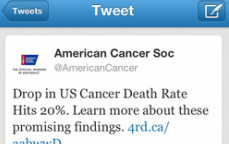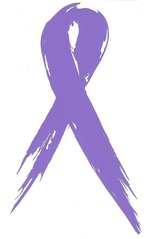A reflection of the accomplishments made by the 2012 Colleges Against Cancer student-led organization at LVC.
 Good news! A recent tweet made by the American Cancer Society states that the cancer death rate in the United States has decreased by twenty percent, a result members of the American Cancer Society are ecstatic about. However, I do not think the statistic of 20% adequately describes how significant this accomplishment is for cancer patients in America. Twenty percent equals four hundred lives being saved from cancer every single day.
This year marks the 100th anniversary of the American Cancer Society which works to “save lives and create a world with less cancer and more birthdays.” Today, the organization has over a million supporters worldwide which all come together to help eliminate cancer as a major health problem. In order to do so they develop programs to help with cancer research, education, advocacy, and patient services programs.
Through events such as Relay For Life and Making Strides Against Breast Cancer the American Cancer Society raises billions of dollars every year. Even students here at LVC have the opportunity to join in the fight against cancer by joining Colleges Against Cancer, led by president Amanda Hanna a senior physical therapy major. The group of students which far exceeds any other student-led organization on campus with over 200 members meets at least once a month to discuss different events to help raise awareness of cancer on our campus. The group is in charge of Pink Week, Great American Smoke Out, Paint the Campus Purple, and Relay For Life.
The work of those involved in ACS organizations does make a difference. Here’s how:
· 1976 - The California Division of the American Cancer Society got nearly one million smokers to quit for the day, marking the first Great American Smokeout®, which became a nationwide event the next year.
· 1978 - Tamoxifen was approved by the PDA for treating estrogen receptor positive breast cancer. Society-funded Bernard Fisher, MD, Richard Love, MD, and V. Craig Jordan, PhD, developed and carried out the first trial of tamoxifen to prevent recurrence in breast cancer survivors
· 1980 - Early detection guidelines for breast cancer were developed.
· 1985 - The first American Cancer Society Relay For Life® was held in Tacoma, Washington. Today, the event is held in nearly 3,400 communities nationwide and raises more than one billion dollars for the Society's cancer research, education, advocacy, and patient services programs.
· 1989 - The Society teamed with the Personal Care Products Council (formerly the Cosmetic, Toiletry and Fragrance Association, or CFTA) to produce Look Good ... Feel Better®, a program which helps women deal with the appearance-related side effects of cancer treatment.
· 1991 - Society-funded research showed that young children recognize Joe Camel as easily as Mickey Mouse, demonstrating that the cartoon character reaches an audience well under the legal smoking age.
· 1998 - The five-year relative survival rate improved to 58%. (In 1960, it was 37% for men and 39% for women.) The FDA approved the use of Herceptin, a monoclonal antibody developed by former Society grantee Dennis Slamon, MD, for treatment of certain breast cancers.
· 2001 - The Society took the lead in successfully convincing Congress to enact new legislation to extend Medicare coverage of colonoscopy to average-risk individuals age 50 or older.
· 2002 - The Society launched a new 501 (c)4 sister organization—the American Cancer Society Cancer Action Network-to provide new opportunities for voter education and direct advocacy for cancer legislation.
· 2007 - An American Cancer Society report showed the first decline in actual number of cancer deaths in the more than 70 years since nationwide data began to be compiled.
· 2013- An American Cancer Society report showed a 20% decrease in the cancer death rate in the United States. 20% is equivalent to 400 lives being saved every day.
If anything, these accomplishments give us reason to hope. Sometimes cancer can push us deep inside ourselves and make us afraid to look toward the future; however, organizations like the American Cancer Society give us hope. They refuse to give up and relentlessly fight to eliminate cancer from our world and have more birthdays as a result. We, those affected by the horrible effects of cancer remain hopeful. We hope for more volunteers. We hope for more doctors and nurses. We hope for more medicine and treatments. We hope for fewer sick patients. We hope for a cure.
 Walk into a room full of people and try to find something you all have in common. I’m sure you would automatically resort to the typical icebreaker questions and begin comparing names, birth dates, hometowns, favorite sport teams and colors. Of course you’ll find a few people that coincidentally share some of your biographical information, but the chances of everyone in that space having an identical set of facts is slim to none. However, bring up the word “cancer” and I’m positive you will have found what you all share. Double, triple, multiply the amount of people in that room by any number and I know the result will be the same. We are all linked by one diagnosis, one disease, one word: cancer.
Cancer has many tests. On the medical side: doctors and scientists work countless hours to find a cure, relieve the pain, and prescribe adequate treatments. On the home front: how do you comfort someone when your world seems to have completely fallen apart? As the patient: you are challenged mentally, physically, and spiritually every day. But the likeliness of overcoming each test increases with perseverance, endurance, and hope.
While each story we could share would inevitably be different, they originate at the same place—with someone receiving the life-altering news “You have cancer.” Three words. So simple. But at the same time so complex. Whether you’re the patient, the doctor, a relative, a friend, or an acquaintance, relaying that news will never be an easy feat.
In 2012 alone, an estimated 1,638,910 new cases of cancer were predicted to be diagnosed in the United States and unfortunately 577,190 American cancer patients were expected to lose their fight against cancer last year. It is important to remember that these statistics are more than just numbers. Each data entry is a life: a mother, father, grandparent, sibling, spouse, best friend, classmate, neighbor, co-worker, the list goes on and on, but it needs to stop.
That’s where I come in. I am refusing to let these numbers continue to grow—to exist at all. I personally believe with enough support we can wipe out cancer. Through fundraising, educating, and simply caring for those affected, we can begin eliminating the horrible effects of cancer one person at a time.
|